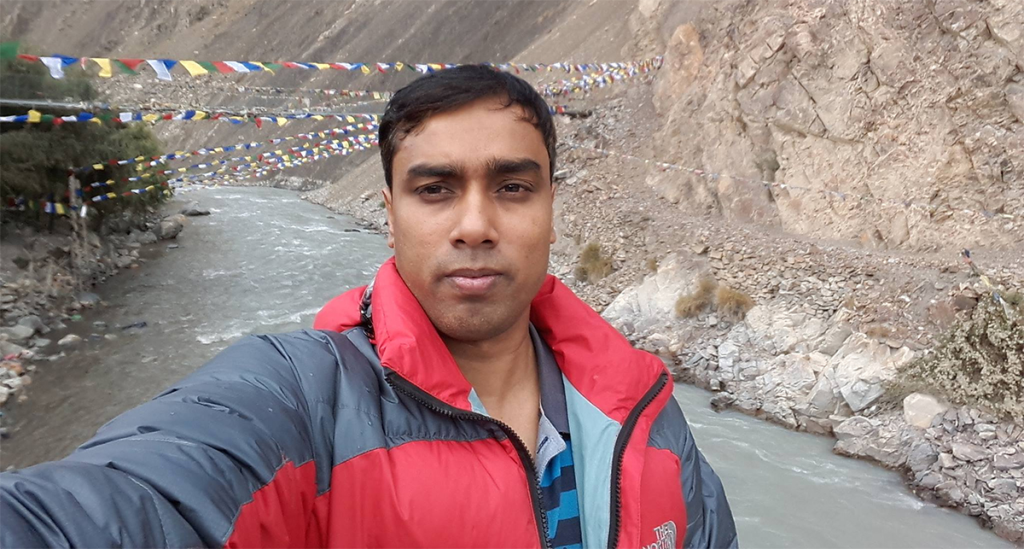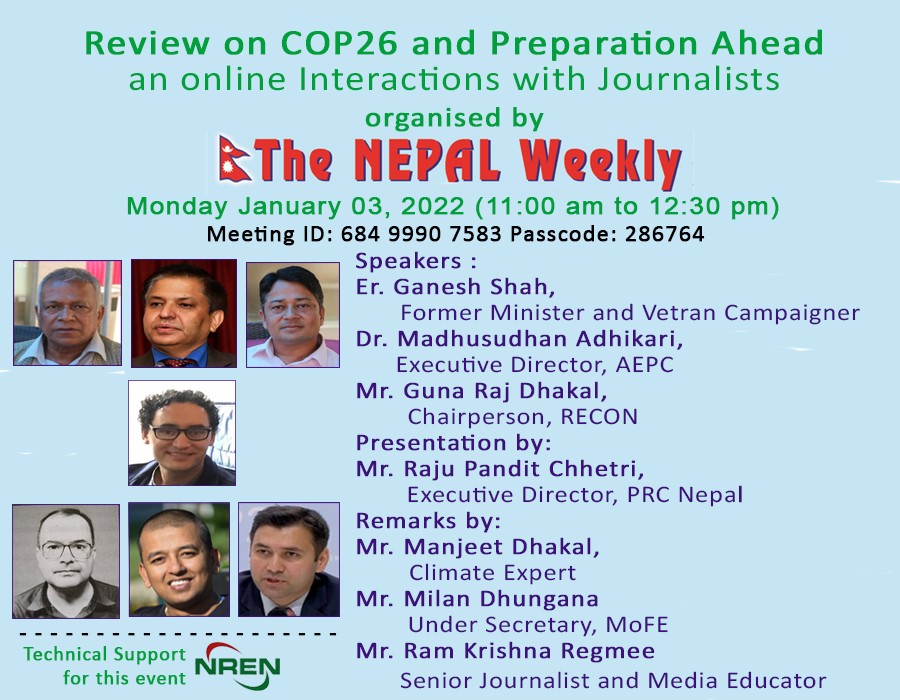 The Nepal Weekly
The Nepal Weekly  October 7, 2025
October 7, 2025
Kathmandu, Oct 5: Jiwan Kumar Mallik is a renewable energy and climate policy expert with 15+ years experience in energy sector. He recently completed his Master in Public Administration from Harvard Kennedy School as a John F. Kennedy Fellow and received the Josephine S. Vernon Award for advancing energy access in underserved communities. He also holds degrees from Pulchowk Campus (B.E. Electrical Engineering) and IIT Delhi (M.Tech. Power Systems). Currently based in Washington DC, Jiwan advises international organizations on energy access, climate finance, and just energy transitions for developing countries.
Last year, when Nepal unveiled its National Energy Roadmap targeting 28,500MW generation and 1,500 kWh per capita consumption by 2035, it promised energy prosperity. But Harvard University graduate Jiwan Mallik who has spent 12 years implementing Nepal’s energy policies sees a different reality: a massive infrastructure gap, severe financing challenges, and political uncertainty that threatens the entire vision. Krishna Adhikari, a senior journalist of RSS interviews Jiwan Mallik on Nepal’s energy roadmap and critical challenges facing the sector.
The National Energy Roadmap envisions 28,500MW by 2035—nearly nine times our current around 3500 MW capacity. What’s your frank assessment ?
The vision is ambitious, but we must confront harsh realities. Despite 99% electrification, electricity comprises only 26% of Nepal’s total energy mix. We still rely heavily on imported fossil fuels—a massive economic burden. Even more concerning, we are not self-reliance and still depends on imported grid electricity from India, showing our vulnerability. We need massive investment in transmission and distribution networks to achieve 1,500 kWh per capita consumption, up from today’s 400 kWh. For context, India is at 1,538 kWh. The roadmap targets 15,000MW export (10,000MW to India, 5,000MW to Bangladesh/China) plus 13,468MW domestic demand by 2035.
Based on my Harvard studies on country-level climate finance, we’re looking at approximately USD 46 billion investment for the entire energy value chain. Government can cover 20-25%. The rest must come from private sector and climate finance. But recent political developments, particularly Gen Z protests, have created high political risk that no rational investor will accept.
Some say we already have surplus electricity. Is that accurate?
This is a dangerous misconception. We don’t have actual surplus—we have seasonal surplus. Last fiscal year 2023/24, we exported 1,946 million units during monsoon but imported 1,895 million units during dry season. Net export was barely 51 million units.
We’re 95%+ dependent on hydropower, which means high generation in monsoon, deficit in dry season. We shouldn’t fear this wet season surplus or blame Run-of-River projects—it’s our reality. But without storage projects like Budhigandaki and Dudhkoshi started immediately, this seasonal dependency will worsen. We risk returning to load-shedding-potentially worse than before—making life unbearable and triggering economic chaos that could destabilize our entire political system. Moreover, climate change is already reducing river flows and damaging infrastructure. This isn’t a future threat-it’s happening now.

The Gen Z protests created significant impact. How does this affect energy sector investment ?
It creates a fundamental dilemma. We desperately need private capital—both domestic and foreign—to build infrastructure. Yet we’re sending signals that capital isn’t welcome. Political risk translates directly into cost of capital.
How does high financing cost affect domestic consumers and the 1,500 kWh per capita target?
The World Bank’s Multi-Tier Framework states energy is affordable only if it costs less than 5% of household income. With high financing costs reflected in tariffs, we’re pricing electricity beyond ordinary households. But there’s opportunity: we can boost domestic consumption through green hydrogen production, data centers, and agro-processing industries. These energy-intensive sectors could absorb surplus monsoon power productively while creating economic value.
Countries like Bhutan are pursuing similar strategies – aiming for 20,000 MW by 2040 through comprehensive national approaches including industrial development. For the 1,500 kWh target, households must use electricity for cooking, heating, cooling. But if tariffs are unaffordable, people won’t switch from LPG to electric cooking. They’ll remain in energy poverty despite grid access.
How do transmission congestion and climate change threaten the roadmap?
We face twin infrastructure challenges. First, transmission bottlenecks: we have only one major cross-border line – the 400kV Dhalkebar – Muzaffarpur – with capacity around 1,000MW. During monsoon, we generate surplus but cannot evacuate it. The roadmap calls for 6,440 circuit-km of 400kV lines, 4,061 ckm of 220kV, and 6,431 ckm of 132kV by 2035. That’s billions of dollars and 7-10 year construction periods.
Second, climate change is already damaging our infrastructure – not a future threat but present reality. Landslides, glacial lake outburst floods, changing river morphology – all affecting project viability. We need resilient infrastructure design and more funds for climate adaptation in project studies. We’re also geopolitically vulnerable. Any geopolitical masterstroke between our neighbors is beyond our managerial capacity. We must be prepared for energy emergencies caused by climate change and geopolitical upheavals.
Based on your experience from Nepal to Pacific Islands to Harvard, what solutions do you propose?
I propose a comprehensive five-point framework: First: De-risk private investment through government-backed guarantees. Government cannot finance USD 40 billion, but can provide partial risk guarantees lowering financing costs from 10% to 6-7%. This requires minimal upfront budget but dramatically improves project viability. Maintain take-or-pay contracts for bankable projects.
Second, Build transmission and storage infrastructure as public good. Generation can be private, but transmission and large storage projects should be government-led with multilateral development bank financing. Start Budhigandaki and Dudhkoshi immediately to address seasonal dependency. Implement open access regulations ensuring fair transmission capacity allocation.
Third, Adopt India’s solar incentive model and develop green industries. Develop solar parks with government support, 8% fixed interest rates, streamlined approvals. Simultaneously, promote green hydrogen, agro-processing, Battery Energy Storage System etc to absorb surplus monsoon power productively.
Fourth, Open power trading to private sector and resolve policy paradoxes. NEA has been sole entity for 40 years. Allow private participation as interim measure until new Electricity Act is enacted. Accelerate grid expansion and associated regulations including transmission pricing and deviation settlement. And fifth is Build political consensus on FDI and climate resilience. Factor climate adaptation costs into all projects and build geopolitical risk management capacity.
Most importantly, we need symbiosis—Government as policy maker and conducive environment creator, private sector as developers, NEA as buyer—all working together without feud. This synergy is essential for economic development spurred by hydropower.
The roadmap targets 2035—just over a decade. Is it achievable?
Achievable? Yes, technically. Likely? Only if we address financing, political risk, and policy paradoxes immediately. Two things must happen in next 12-18 months: One is Create de-risking facility providing guarantees and concessional finance. Maintain bankable contract structures. Start storage projects immediately to avoid future load-shedding. And another is enact new Electricity Bill resolving all policy paradoxes. Adopt enabling regulatory reforms—streamlined approvals, infrastructure support for solar/wind, open access regulations, private sector power trading licenses, climate-resilient project designs.
Countries like Vietnam attracted USD 50+ billion in renewable energy by maintaining policy stability. Bhutan is pursuing 20,000 MW by 2040 through comprehensive national strategy. Nepal can achieve its vision, but only with urgent, decisive action. If we fail, we risk not just energy crisis but economic chaos and political instability. The soft sirens are already sounding. We must heed them without delay, stop playing hypocrisy, and work out proper policies before it’s too late.

